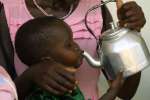More than 46,000 people cross Gulf of Aden in first six months of the year
News Stories, 6 August 2013
GENEVA, August 6 (UNHCR) – The UN refugee agency on Tuesday said it was concerned by the growing number of people risking their lives to reach Yemen by boat from Africa after recording the arrival on the Yemeni coast of more than 46,000 refugees and migrants during the first six months of this year.
The number of asylum-seekers, refugees and migrants in Yemen has been rising for the past six years. Last year, a record 107,500 people made the journey. And while numbers are lower so far this year – 46,417 from January through June, compared to 56,146 for the same period in 2012 – the number of arrivals is significant. Since 2006, close to half-a-million people have arrived in Yemen through mixed-migration movements.
"We have witnessed a significant change in the refugee and migrant population arriving in Yemen over the past two years, with more Ethiopians making the crossing and citing the difficult situation at home," UNHCR's chief spokesperson, Melissa Fleming, told journalists in Geneva on Tuesday.
Previously, Somali refugees made up between one-third and one-quarter of total arrivals. Of the people who arrived in Yemen in the first half of this year, 38,827 (84 per cent) are Ethiopian, while 7,559 (16 per cent) are Somali.
Most of the new arrivals reached Yemen in February-March and across the Red Sea. Of the total, 34,875 arrived via the Red Sea – and mainly in Lahij Governorate. The other 11,542 arrived via the Arabian Sea – mainly in Hadramout Governorate.
Refugees and migrants are vulnerable to exploitation, violence and sexual abuse at all stages of their journeys. Boats crossing the Arabian Sea or Red Sea to Yemen are often overcrowded. Smugglers may force passengers into the water to avoid detection. Smugglers and traffickers often wait on the coast to receive the new arrivals.
The Yemeni authorities recognize Somali arrivals as refugees automatically. UNHCR determines the refugee status of Ethiopians and other nationals. Though few Ethiopians seek asylum – partly because most want to travel on beyond Yemen or they don't know how the asylum process works. As a result, most Ethiopians are left extremely vulnerable.
There are positive developments. The number of dead or missing refugees and migrants has dropped significantly – to five people so far this year from 43 in all of 2012. And in Yemen, a traditional transit hub for migrants and a country hosting more than 240,000 refugees, migration monitoring is relatively well managed. Yemeni authorities have also enjoyed some success in locating smugglers' and traffickers' bases and cracking down on their operations.
While UNHCR remains concerned by the continued high numbers of asylum-seekers and migrants arriving in Yemen from the Horn of Africa, the agency is also engaged with the Yemeni government and national and international partners. "Together we are working to enhance services offered to refugees, asylum seekers and migrants as well as find sustainable solutions," Fleming said.
UNHCR and its partners, such as the Yemen Red Crescent Society and the Danish Refugee Council, work daily to record new arrivals and offer them support. That help takes many forms, including food and water, first aid and transportation to transit and reception centres – hot meals, welcome packages including blankets and clothing, accommodation and counselling.
















































